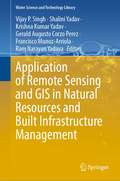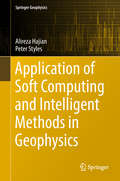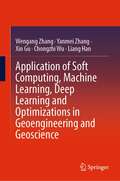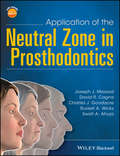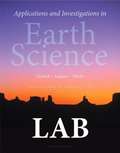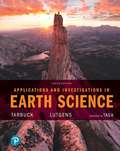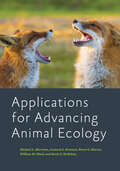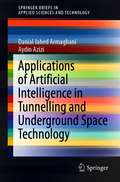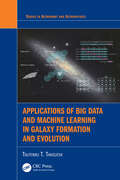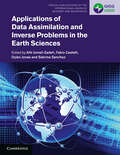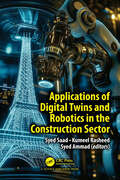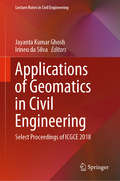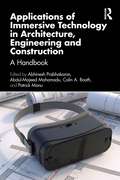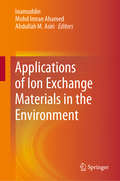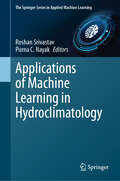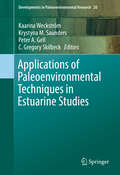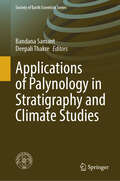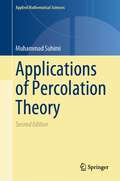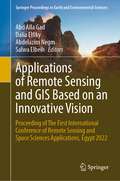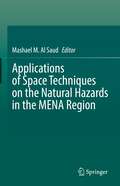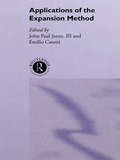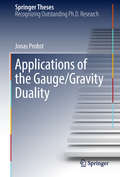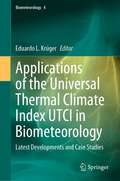- Table View
- List View
Application of Remote Sensing and GIS in Natural Resources and Built Infrastructure Management (Water Science and Technology Library #105)
by Vijay P. Singh Shalini Yadav Ram Narayan Yadava Krishna Kumar Yadav Gerald Augusto Corzo Perez Francisco Muñoz-ArriolaThis book discusses the problems in planning, building, and management strategies in the wake of application and expansion of remote sensing and GIS products in natural resources and infrastructure management. The book suggests proactive solutions to problems of natural resources and infrastructure management, providing alternatives for strategic planning, effective delivery, and growth perspectives. The uniqueness of the book is its broader spectrum of coverage with related interconnections and interdependences across science, engineering, and innovation. The book contains information that can be downscaled to the local level. Presenting a wide spectrum of viewpoints and approaches, the book is a collective of topics such as application to agriculture and forestry (land and landscape, agriculture, forestry management and deforestation), water resources and ecology (hydro-meteorological, climate diagnostics, and prognostics, water resources management, environment management, cross-scale ecology and resilience), urban management (urban planning, design, construction and operations of infrastructure, natural disasters, novel approaches to upgrade old infrastructure), hydro informatics, predictive and geospatial data analytics, synthesis, and management through the various processes, tools, and technologies.
Application of Soft Computing and Intelligent Methods in Geophysics (Springer Geophysics)
by Alireza Hajian Peter StylesThis book provides a practical guide to applying soft-computing methods to interpret geophysical data. It discusses the design of neural networks with Matlab for geophysical data, as well as fuzzy logic and neuro-fuzzy concepts and their applications. In addition, it describes genetic algorithms for the automatic and/or intelligent processing and interpretation of geophysical data.
Application of Soft Computing, Machine Learning, Deep Learning and Optimizations in Geoengineering and Geoscience
by Wengang Zhang Xin Gu Yanmei Zhang Chongzhi Wu Liang HanThis book summarizes the application of soft computing techniques, machine learning approaches, deep learning algorithms and optimization techniques in geoengineering including tunnelling, excavation, pipelines, etc. and geoscience including the geohazards, rock and soil properties, etc. The book features state-of-the-art studies on use of SC,ML,DL and optimizations in Geoengineering and Geoscience. Considering these points and understanding, this book will be compiled with highly focussed chapters that will discuss the application of SC,ML,DL and optimizations in Geoengineering and Geoscience. Target audience: (1) Students of UG, PG, and Research Scholars: Several applications of SC,ML,DL and optimizations in Geoengineering and Geoscience can help students to enhance their knowledge in this domain. (2) Industry Personnel and Practitioner: Practitioners from different fields can be able to implement standard and advanced SC,ML,DL and optimizations for solving critical problems of civil engineering.
Application of the Neutral Zone in Prosthodontics
by Charles J. Goodacre David R. Cagna Joseph J. Massad Russell A. Wicks Swati A. AhujaApplication of the Neutral Zone in Prosthodontics offers a step-by-step guide to successfully designing and placing complete and implant-retained dentures using neutral zone concepts. Illustrates every technique described with more than 300 color photos Covers all phases of complete denture therapy Presents a step-by-step assessment and examination protocol Details the importance of accurate diagnosis and prognosis prior to committing to treatment Describes an alternative to traditional impressioning procedures that can be accomplished in a single appointment Includes access to a companion website with video clips and student handouts, with teaching PowerPoints available for instructors
Applications and Challenges of Geospatial Technology: Potential and Future Trends
by Pavan Kumar Meenu Rani Prem Chandra Pandey Haroon Sajjad Bhagwan Singh ChaudharyThis book advances the scientific understanding and application of space-based technologies to address a variety of areas related to sustainable development; including environmental systems analysis, environmental management, clean processes, green chemistry, and green engineering. Geo-spatial techniques have gained considerable interest in recent decades among the earth and environmental science communities for solving and understanding various complex problems and approaches towards sustainable technologies. The book encompasses several scopes of interests on sustainable technologies in areas such as water resources, forestry, remote sensing, meteorology, atmospheric and oceanic modeling, environmental engineering and management, civil engineering, air and environmental pollution, water quality problems, etc. The book will appeal to people with an interest in geo-spatial techniques, sustainable development and other diverse backgrounds within earth and environmental sciences field.
Applications and Investigations in Earth Science
by Edward J. Tarbuck Frederick K. Lutgens Dennis G. Tasa Kenneth G. PinzkeDesigned to accompany Tarbuck and Lutgen's Earth Science and Foundations of Earth Science , this manual can be used for any Earth Science lab course, in conjunction with any text. The Eighth Edition minimizes the need for faculty instruction in the lab, freeing instructors to interact directly with students. Widely praised for its concise coverage and dynamic illustrations by Dennis Tasa, the text contains twenty-three step-by-step exercises that reinforce major topics in geology, oceanography, meteorology, and astronomy.
Applications and Investigations in Earth Science
by Dennis Tasa Edward Tarbuck Frederick LutgensPerfect for use with any Earth Science text, this versatile collection of introductory-level laboratory experiences examines the basic principles and concepts of the Earth sciences. Widely praised for its concise coverage and dynamic illustrations by Dennis Tasa, the text contains twenty-three step-by-step exercises that reinforce major topics in geology, oceanography, meteorology, and astronomy. The Seventh Edition offers over 80 new photos, redrawn illustrations, and safety "Caution" boxes throughout.
Applications for Advancing Animal Ecology (Wildlife Management and Conservation)
by Michael L. Morrison Bruce G. Marcot Leonard A. Brennan William M. Block Kevin S. McKelveyPractical guidance for wildlife professionals working to improve study design, data analysis, and the application of results to habitat and population management.Despite major advances in sampling techniques and analytical methods, many animal ecologists conduct research that is primarily relevant to a specific time and place. They also tend to focus more on the statistical analyses and nuances of modeling than actual study design. Arguing that studies of animal ecology should always begin with a focus on the behaviors and characteristics of individual organisms, including how they form into distinct biological populations, Applications for Advancing Animal Ecology takes a fresh and critical look at the field. Building from its companion volume, Foundations for Advancing Animal Ecology, this practical book presents readers with the principal methods used to observe animal behavior. Teaching them to assess resource abundance categories of species-environmental relationships models, it also explores• major aspects of measuring animal habitat: what to measure and how to measure it;• common sampling and estimation methods to assess population parameters;• when to measure and how to analyze data;• problems that will confront ecologists in the coming years—and how to gather information to adequately address them; and• how the experimental approach can be used to advance the science of animal ecology.Throughout the book, the authors stress the importance of speaking a common and well-defined language. Avoiding vague and misleading terminology, they assert, will help ecologists translate science into meaningful and lasting actions in the environment. Taking the perspective of the organism of interest in developing concepts and applications, the authors always keep the potentially biased human perspective in focus. They also provide a selection of suggested research projects, cautions, and caveats. A major advancement in understanding the factors underlying wildlife–habitat relationships, Applications for Advancing Animal Ecology will be an invaluable resource to natural resource management professionals and practitioners, including state and federal agencies, non-governmental organizations, and environmental consultants.
Applications of Artificial Intelligence in Tunnelling and Underground Space Technology (SpringerBriefs in Applied Sciences and Technology)
by Aydin Azizi Danial Jahed ArmaghaniThis book covers the tunnel boring machine (TBM) performance classifications, empirical models, statistical and intelligent-based techniques which have been applied and introduced by the researchers in this field. In addition, a critical review of the available TBM performance predictive models will be discussed in details. Then, this book introduces several predictive models i.e., statistical and intelligent techniques which are applicable, powerful and easy to implement, in estimating TBM performance parameters. The introduced models are accurate enough and they can be used for prediction of TBM performance in practice before designing TBMs.
Applications of Big Data and Machine Learning in Galaxy Formation and Evolution (Series in Astronomy and Astrophysics)
by Tsutomu T. TakeuchiAs investigations into our Universe become more complex, in-depth, and widespread, galaxy surveys are requiring state-of-the-art data scientific methods to analyze them. This book provides a practical introduction to big data in galaxy formation and evolution, introducing the astrophysical basics, before delving into the latest techniques being introduced to astronomy and astrophysics from data science. This book helps translate the cutting-edge methods into accessible guidance for those without a formal background in computer science. It is an ideal manual for astronomers and astrophysicists, in addition to graduate students and postgraduate students in science and engineering looking to learn how to apply data-science to their research.Key Features: Introduces applications of data-science methods to the exciting subject of galaxy formation and evolution Provides a practical guide to understanding cutting-edge data-scientific methods, as well as classical astrostatistical methods Summarises a vast range of statistical and informatics methods in one volume, with concrete applications to astrophysics
Applications of Data Assimilation and Inverse Problems in the Earth Sciences (Special Publications of the International Union of Geodesy and Geophysics #5)
by Dylan Jones Alik Ismail-Zadeh Fabio Castelli Sabrina SanchezMany contemporary problems within the Earth sciences are complex, and require an interdisciplinary approach. This book provides a comprehensive reference on data assimilation and inverse problems, as well as their applications across a broad range of geophysical disciplines. With contributions from world leading researchers, it covers basic knowledge about geophysical inversions and data assimilation and discusses a range of important research issues and applications in atmospheric and cryospheric sciences, hydrology, geochronology, geodesy, geodynamics, geomagnetism, gravity, near-Earth electron radiation, seismology, and volcanology. Highlighting the importance of research in data assimilation for understanding dynamical processes of the Earth and its space environment and for predictability, it summarizes relevant new advances in data assimilation and inverse problems related to different geophysical fields. Covering both theory and practical applications, it is an ideal reference for researchers and graduate students within the geosciences who are interested in inverse problems, data assimilation, predictability, and numerical methods.
Applications of Digital Twins and Robotics in the Construction Sector
by Syed Saad Syed Ammad Kumeel RasheedThis book provides insights to the lay person as well as the experts who are actively enabling these changes in the construction industry. The book explores digital twins and robots in the construction sector, and how they are revolutionizing this field. It comprises chapters that begin with the basics before going upstream. Digital Twins are important in the planning and design of projects where, real-time simulation, visualization and data-driven decision-making are done. Furthermore, robotics play a significant role in on-site execution, thus automating construction operations, and guaranteeing accuracy and safety. The book discusses the harmony of digital twinning and robotics, showing that these two are complementary with regard to enhancing efficiencies on-site, in monitoring progress and live control.Applications of Digital Twins and Robotics in the Construction Sector covers the current applications of these technologies and forecasts future applications, exposing readers to breakthrough innovations transforming this field. It aims inform all readers, expert or simply interested and inquisitive about digital twins and construction robots’ transformation.
Applications of Geomatics in Civil Engineering: Select Proceedings of ICGCE 2018 (Lecture Notes in Civil Engineering #33)
by Jayanta Kumar Ghosh Irineu Da SilvaThis book comprises select proceedings of the First International Conference on Geomatics in Civil Engineering (ICGCE 2018). This book presents latest research on applications of geomatics engineering in different domains of civil engineering, like structural engineering, geotechnical engineering, hydraulic and water resources engineering, environmental engineering and transportation engineering. It also covers miscellaneous applications of geomatics in a wide range of technical and societal problems making use of geospatial information, engineering principles, and relational data structures involving measurement sciences. The book proves to be very useful for the scientific and engineering community working in the field of geomatics and geospatial technology.
Applications of Immersive Technology in Architecture, Engineering and Construction: A Handbook (Spon Research)
by Colin A. Booth Patrick Manu Abdul-Majeed Mahamadu Abhinesh PrabhakaranThis edited book addresses a gap in literature by advancing current understandings of the applications of immersive technology within the architecture, engineering and construction (AEC) sector.Globally, the architecture, engineering and construction (AEC) sector makes an enormous contribution to the socio-economic development of nations, which is primarily evidenced by its creation/provision of the built environment. The sector has, however, often been criticised for inefficiencies, waste and diverse forms of adverse impacts that are associated with the lifecycle of the provision of built assets – design, construction, operations and maintenance and end-of-life phases. Over the years, the inefficiencies, waste and adverse impacts have often been a catalyst for calls and initiatives to transform the AEC sector. The advent of the fourth industrial revolution (commonly referred to as, ‘Industry 4.0’), which entails the automation and digitalisation of production, presents opportunities to leverage emerging technologies to improve the image and productivity of the sector. Prominent among the emerging technologies in the Industry 4.0 era is that of immersive technology, which includes virtual reality, mixed reality and augmented reality. The capability of immersive technology to deliver beneficial impacts for multiple construction sector stakeholders throughout the construction lifecycle has been acknowledged within the industry and this continues to stimulate interest amongst practitioners, policymakers and researchers. Despite this phenomenon, at present there is no dedicated compendium of research-informed text that focusses on the multifaceted applications of immersive technology throughout the lifecycle of the provision of built assets right from concept design to end-of-life.This book thus addresses this gap in literature by advancing current understanding of the applications of immersive technology within the AEC industry. Readers will understand how the technologies are applied, the resulting array of impacts including benefits, drawbacks, challenges and future directions for applications, research and development.
Applications of Ion Exchange Materials in the Environment
by Inamuddin Abdullah M. Asiri Mohd Imran AhamedThis book presents the applications of ion-exchange materials in the area of environmental analysis and treatment. It includes chapters on applications of organic, inorganic and composite ion exchange materials and hexacyanoferrates in various fields such as chemical and biochemical separations, water purification, removal of harmful impurities, dyes and cationic and anionic complexes. This title is a highly valuable source of knowledge on ion-exchange materials and their applications suitable for postgraduate students and researchers but also to industrial R&D specialists in chemistry, chemical, and biochemical technology. Additionally, this book will provide an in-depth knowledge of ion-exchange column and operations suitable for engineers and industrialists.
Applications of Machine Learning in Hydroclimatology (The Springer Series in Applied Machine Learning)
by Roshan Srivastav Purna C. NayakApplications of Machine Learning in Hydroclimatology is a comprehensive exploration of the transformative potential of machine learning for addressing critical challenges in water resources management. The book explores how artificial intelligence can unravel the complexities of hydrological systems, providing researchers and practitioners with cutting-edge tools to model, predict, and manage these systems with greater precision and effectiveness. It thoroughly examines the modeling of hydrometeorological extremes, such as floods and droughts, which are becoming increasingly difficult to predict due to climate change. By leveraging AI-driven methods to forecast these extremes, the book offers innovative approaches that enhance predictive accuracy. It emphasizes the importance of analyzing non-stationarity and uncertainty in a rapidly evolving climate landscape, illustrating how statistical and frequency analyses can improve hydrological forecasts. Moreover, the book explores the impact of climate change on flood risks, drought occurrences, and reservoir operations, providing insights into how these phenomena affect water resource management. To provide practical solutions, the book includes case studies that showcase effective mitigation measures for water-related challenges. These examples highlight the use of machine learning techniques such as deep learning, reinforcement learning, and statistical downscaling in real-world scenarios. They demonstrate how artificial intelligence can optimize decision-making and resource management while improving our understanding of complex hydrological phenomena. By utilizing machine learning architectures tailored to hydrology, the book presents physics-guided models, data-driven techniques, and hybrid approaches that can be used to address water management issues. Ultimately, Applications of Machine Learning in Hydroclimatology empowers researchers, practitioners, and policymakers to harness machine learning for sustainable water management. It bridges the gap between advanced AI technologies and hydrological science, offering innovative solutions to tackle today's most pressing challenges in water resources.
Applications of Palaeontology
by Robert Wynn JonesPalaeontology, the scientific study of fossils, has developed from a descriptive science to an analytical science used to interpret relationships between earth and life history. This book provides a comprehensive and thematic treatment of applied palaeontology, covering the use of fossils in the ordering of rocks in time and in space, in biostratigraphy, palaeobiology and sequence stratigraphy. Robert Wynn Jones presents a practical workflow for applied palaeontology, including sample acquisition, preparation and analysis, and interpretation and integration. He then presents numerous case studies that demonstrate the applicability and value of the subject to areas such as petroleum, mineral and coal exploration and exploitation, engineering geology and environmental science. Specialist applications outside of the geosciences (including archaeology, forensic science, medical palynology, entomopalynology and melissopalynology) are also addressed. Abundantly illustrated and referenced, Applications of Palaeontology provides a user-friendly reference for academic researchers and professionals across a range of disciplines and industry settings.
Applications of Paleoenvironmental Techniques in Estuarine Studies (Developments in Paleoenvironmental Research #Volume 20)
by Kaarina Weckström Krystyna M. Saunders Peter A. Gell C. Gregory SkilbeckThe aim of this edited volume is to introduce the scientific community to paleoenvironmental studies of estuaries, to highlight the types of information that can be obtained from such studies, and to promote the use of paleoenvironmental studies in estuarine management. <P><P> Readers will learn about the the application of different paleoecological approaches used in estuaries that develop our understanding of their response to natural and human influences. Particular attention is given to the essential steps required for undertaking a paleoecological study, in particular with regard to site selection, core extraction and chronological techniques, followed by the range of indicators that can be used. A series of case studies are discussed in the book to demonstrate how paleoecological studies can be used to address key questions, and to sustainably manage these important coastal environments in the future. This book will appeal to professional scientists interested in estuarine studies and/or paleoenvironmental research, as well as estuarine managers who are interested in the incorporation of paleoenvironmental research into their management programs.
Applications of Palynology in Stratigraphy and Climate Studies (Society of Earth Scientists Series)
by Bandana Samant Deepali ThakreThis book highlights the importance of palynology in understanding floral biodiversity, paleoclimate and depositional environments in deep time and recent sediments. It includes contributions from renowned Indian palynologists who work on the applied aspects of palynology. The book focuses on the significance of palynology in solving various geological problems, ranging from the Precambrian to the Recent. This book will be useful to graduate and postgraduate students, researchers, and academicians working in geology and botany, as well as international researchers interested in palynological research work in India.
Applications of Percolation Theory (Applied Mathematical Sciences #213)
by Muhammad SahimiThe first edition of this book was published in 1994. Since then considerable progress has been made in both theoretical developments of percolation theory, and in its applications. The 2nd edition of this book is a response to such developments. Not only have all of the chapters of the 1st edition been completely rewritten, reorganized, and updated all the way to 2022, but also 8 new chapters have been added that describe extensive new applications, including biological materials, networks and graphs, directed percolation, earthquakes, geochemical processes, and large-scale real world problems, from spread of technology to ad-hoc mobile networks.
Applications of Remote Sensing and GIS Based on an Innovative Vision: Proceeding of The First International Conference of Remote Sensing and Space Sciences Applications, Egypt 2022 (Springer Proceedings in Earth and Environmental Sciences)
by Abdelazim Negm Abd Alla Gad Dalia Elfiky Salwa ElbeihThis book covers various aspects of remote sensing and geographic information systems, from the perspective of earth and environmental sciences. The theme of applications of remote sensing and geographic information systems for the purposes of sustainable development highlights the innovative usage of space imaged spectral data in soil characterization. This book merges the selected contributions to the First International Conference of Remote Sensing and Space Sciences Applications (Egypt 2022) aiming to promote the latest findings on the development of Space Technologies and Applications.
Applications of Space Techniques on the Natural Hazards in the MENA Region
by Mashael M. Al SaudThis book introduces a comprehensive understanding in the use of space techniques in natural hazards and risk management in the MENA Region. The book is based on different case-studies from 25 MENA countries, and will be useful in highlighting the issues from all aspects. In recent years the number of natural hazard events has increased in the MENA Region. This is exacerbated by the changing climate and extreme climate events, as well as a large increase in the population in this area. Disastrous events occur on a yearly basis characterized by a vulnerability of physical processes. Floods, earthquakes, and mass movement result in severe damage to property and livelihoods, and have devastating effects upon the environment. These events cause severe financial losses, which on an annual basis, can exceed millions of dollars. The predication, assessment and monitoring approaches remain inadequate in managing these hazards and in mitigating their impacts, but with the development of space techniques and geo-information systems, these situations can now be better managed. The miscellany of satellite images, with different spatial and temporal resolutions, enable the detection of terrain features and provide indications of potential natural risks. This book will of interest to stakeholders, including field experts, academics, researchers and decision makers.
Applications of the Expansion Method
by John Paul JonesFirst published in 2004. Routledge is an imprint of Taylor & Francis, an informa company.
Applications of the Gauge/Gravity Duality (Springer Theses)
by Jonas ProbstMany open questions in Theoretical Physics pertain to strongly interacting quantum systems such as the quark-gluon plasma (QGP) produced in heavy-ion collisions or the strange-metal phase observed in many high-temperature superconductors. These systems are notoriously difficult to study using traditional methods such as perturbation theory, but the gauge/gravity duality offers a successful alternative approach, which maps strongly interacting quantum gauge theories to computationally tractable, classical gravity theories. This book begins with a pedagogical introduction to how the duality can be used to extract transport properties of quantum systems from their gravity dual. It then presents new results on hydrodynamic transport in strongly interacting quantum fluids, providing strong evidence that the Haack-Yarom identity between second-order transport coefficients holds for all fluids with a classical gravity dual and may be a universal feature of all strongly coupled quantum fluids such as the QGP. Newly derived Kubo formulae, expressing transport coefficients in terms of quantum correlators, hold independently of the duality. Lastly, the book discusses new results on magnetic impurities in strongly correlated metals, including the first dual gravity description of an inter-impurity coupling, crucial for the quantum criticality underlying the strange-metal phase.
Applications of the Universal Thermal Climate Index UTCI in Biometeorology: Latest Developments and Case Studies (Biometeorology #4)
by Eduardo L. KrügerThis book introduces the UTCI (Universal Thermal Climate Index) and summarizes progress in this area. The UTCI was developed as part of the European COST Action Program and first announced to the scientific community in 2009. Since then, a decade has followed of applicability tests and research results, as well as knowledge gained from applying the UTCI in human adaptation and thermal perception. These findings are of interest to researchers in the interdisciplinary areas of biometeorology, climatology and urban planning. The book summarizes this progress, discussing the limitations found and provides pointers to future developments. It also discusses UTCI applications in the areas of human biometeorology and urban planning including possibilities of using UTCI and similar indices in climate-responsive urban planning. The book’s message is illustrated with many case studies from the real world.Chapter 10 is available open access under a Creative Commons Attribution 4.0 International License via link.springer.com.
